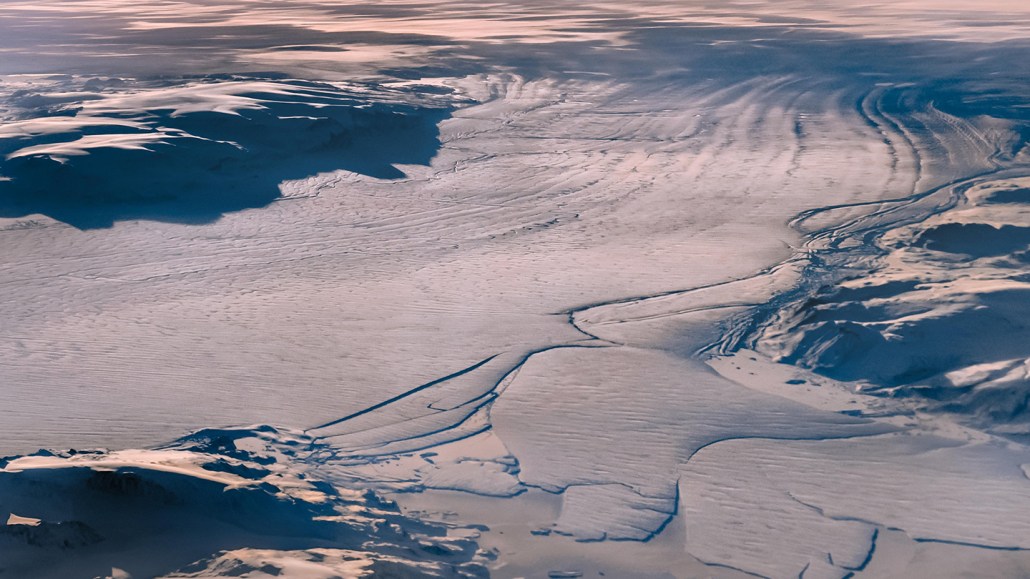Greenland’s inland ice is melting far faster than anyone thought
Sea level rise in coming decades now appears more dire than earlier estimates had predicted

The Nioghalvfjerdsfjord glacier (pictured) is one outlet of the roughly 600-kilometer-long (370-mile-long) Northeast Greenland Ice Stream, which drains ice from the country’s massive ice sheet into the sea.
Guardian_v2/Alamy Stock Photo
Share this:
- Share via email (Opens in new window) Email
- Click to share on Facebook (Opens in new window) Facebook
- Click to share on X (Opens in new window) X
- Click to share on Pinterest (Opens in new window) Pinterest
- Click to share on Reddit (Opens in new window) Reddit
- Share to Google Classroom (Opens in new window) Google Classroom
- Click to print (Opens in new window) Print
By Nikk Ogasa
A gargantuan flow of ice is slithering out of Greenland’s remote interior. On its way to the sea, it’s been speeding up, a new study finds. And it’s been shrinking as it melts. These combined trends point to a likelihood that global sea-level rise may speed up in coming decades — faster than anyone expected.
Within 80 years, the new study finds, what’s happening to this ice stream could raise sea levels by nearly 16 millimeters (or more than six tenths of an inch). That’s more than six times what previous estimates had forecast.
Scientists described their findings Nov. 9 in Nature.
What’s happening in Greenland may not be unique. Climate change may be triggering a withering and accelerating melt of inland parts of large ice flows elsewhere, says glacier scientist Shfaqat Abbas Khan. And if that’s true, past research has likely greatly underestimated the rates at which these melting stores of ice will boost sea levels. Khan works at the Technical University of Denmark in Kongens Lyngby.
“It’s not something that we expected,” Khan says. “Greenland and Antarctica’s contributions to sea-level rise in the next 80 years will be significantly larger than we have predicted until now.”
Accelerating melt rate moves ‘upstream’
Khan was part of a team that studied the Northeast Greenland Ice Stream. This titanic flow of solid ice crawls out of Greenland’s interior. It flows some 600 kilometers (about 375 miles) to the sea. On its way, it drains almost one-ninth of the country’s entire ice sheet. This fast-moving ice contains enough water to raise sea levels more than a meter (39 inches). Near the coast, the ice stream splits into two glaciers (Nioghalvfjerdsfjord and Zachariae Isstrøm).
While frozen, these glaciers keep the ice behind them from rushing into the sea. They work in much the same way that dams hold back water in a river. When the Zachariae Isstrøm ice shelf collapsed about a decade ago, scientists found that the flow of ice behind the glacier started speeding up. But no one was sure whether those changes continued deep into Greenland’s interior.
“We’ve mostly concerned ourselves with the margins [edges],” says Jenny Turton. She did not take part in the new work. But she knows a lot about the subject; she’s a scientist who studies the atmosphere and frozen world for Arctic Frontiers. It’s a nonprofit research group in Tromsø, Norway. She notes that those glacial edges are where scientists have observed the most dramatic changes with the greatest impacts on sea-level rise.
Keen to measure small rates of ice-stream action far inland, Khan and his colleagues turned to GPS. In the past, that tech has revealed the slow, tortuous creeping of Earth’s tectonic plates. The team analyzed GPS data from three stations along the ice stream’s main trunk. All were 90 to 190 kilometers (56 to 118 miles) inland.
The ice stream had sped up from 2016 to 2019 at all three points where they measured it. In that time, the speed at the station farthest inland had increased by at least 7 meters (23 feet) per year. By then, it was traveling at least 351 meters (1,150 feet) per year.
The researchers then compared the GPS measurements with data collected by satellites and aircraft surveys. Those aerial data backed up the GPS findings. Together, these showed that the ice stream’s speedup had moved as far as 200 kilometers (124 miles) upstream. What’s more, the ice stream’s shrinking — or thinning — started in 2011. By 2021, that thinning at Zachariae Isstrøm was now visible more than 250 kilometers upstream.
“This is showing that glaciers are responding along their length faster than we had thought previously,” says Leigh Stearns. She was not part of the new study. But she is a glacier expert at the University of Kansas in Lawrence.
Learning what to expect
Khan and his team used their new data to revise a computer model. It forecasts the ice stream’s impact on sea-level rise. That model now predicts that by 2100, the ice stream will have contributed between about 14 to 16 millimeters to global sea-level rise. That’s as much as the entire Greenland ice sheet has raised seas in the last 50 years.
The findings suggest that past research likely underestimated rates of sea-level rise from this ice stream, Stearns and Turton say. Similarly, upstream thinning and acceleration in other large ice flows — such as those associated with Antarctica’s shrinking Pine Island and Thwaites glaciers — might further boost the rate of sea level rise, Turton says.
Khan’s group plans to look at inland sections of other large ice flows in Greenland and Antarctica to investigate that. Making such forecasts, Stearns says, is key to helping coastal communities adapt to climate change.






